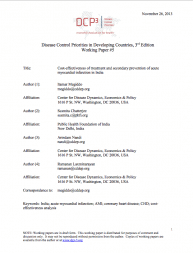November 26, 2013

The Question
How cost-effective are policies that expand the use of aspirin, injection streptokinase, beta blockers, ACE inhibitors (ACEI), and statins for the treatment and secondary prevention of acute myocardial infarction (AMI) in India? How cost-effective would a hypothetical polypill (a combination of the aforementioned drugs) be for secondary prevention?
What we found
Cardiovascular diseases are the single largest cause of death in India, with acute myocardial infarction (AMI), commonly known as heart attack, accounting for a third of all heart disease deaths. We conducted a cost-effectiveness analysis following WHO guidelines for calculating the cost-effectiveness ratio of each intervention and found that increasing coverage of AMI treatment with aspirin and streptokinase is cost-effective. Secondary prevention with aspirin and beta-blockers at 80% coverage is highly cost-effective, as is the addition of ACEI.
Why it matters
Our findings show that there should be a focus on widespread increases in the regimen of preventive drugs. Increasing primary treatment and reducing the time from pain onset to treatment can further alleviate the burden.

